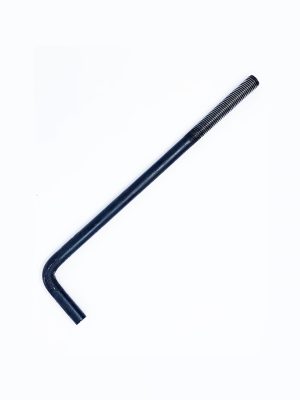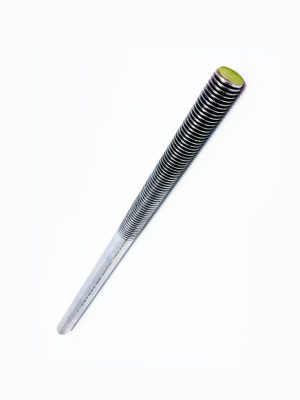- 630 . 882 . 9010
What Is A Threaded Rod?
New employees now getting involved in the electrical, general construction, OEM, pipe valve or fitting industries have probably been introduced to the threaded rod. Threaded along its length, the rod is used in the various trades mentioned.
Which threaded rod is used in particular application depends on a number of variables including thread direction, the length of the rod, the stud thread type, the rod material, its finish, and its size and dimension.
Thread Direction Of Threaded Rods
There are three types of threading. They include:
- Right hand
- Left hand
- A combination of left and right
Right Hand Threading
Arranged in a clockwise rotation, a right threaded thread rod is constructed in such a way that the threads tighten to a fastener.
Left Hand Threading
Arranged in a counter-clockwise fashion, the threads of this type of rod are also designed to tighten the rod to a fastener.
Combination Of Right And Left Hand Threading
Rods with this style of threading will feature different thread directions on each end of them. In other words, the right hand threading is on one side and the left hand threading is on the other side.
It is also important to understand the length of the threaded rod because different lengths of the rod and the different thread types are referred to with different names.
The Length Of The Rod
Typically, threaded rods that are less than 12-inches long are called a stud. On the other hand, threaded rods that are 12-inches long or longer are called threaded rods.
Stud Thread Types
There are three types of stud thread rods on the market –- fully threaded, which describes rods that are threaded from one end to the other, and sing-end and double-end. A single-end stud has threads on one end of the stud and the double end stud has threads at both ends with an unthreaded center area that is called the blank.
The length of threads on a double-end stud can be equal or unequal allowing more threads on one side of the stud than the other.
Rod Materials
Threaded products are available in an assortment of finishes and materials. Which finish and material you use depends on the application. Regardless of the size, shape, color, or material, each rod is used under a specific amount of tension. That amount of tension is the breaking point of the material.
Types Of Metals
The most common type of medal used in the production of threaded rods includes low carbon steel and B7 and stainless steel. There are other metals that are used in the manufacturing of rods. They include Grade 5 and Grade 8 metals as well as stainless steel 303, 304, 316, and A449, brass, aluminum, copper, and silicon bronze.
When choosing the proper material of your rod, it is essential that you know what tensile strength is needed for the specific application in which the rod is used.
Tensile strength is the maximum tension that can be applied before a fastener will fracture or fail. An engineer will designate the appropriate maximum tension and display it on the specifications of the project.
Types Of Finishes
The finish of the rod you use relies on the use of the rod or the application in which the rod is used. The most common finishes for rods include zinc chromate, also known as clear zinc; zinc dichromate, also known as yellow zinc; black oxide; and hot-dip galvanized.
Size And Dimensions
There are so many different shapes and sizes of rods, so what dimension rod to use can be confusing. The most important dimensions you should know and measure of a threaded product are the diameter, the thread pitch, and the length.
Thread pitch is the amount of threads per inch. There are four main thread pitch measurement types –- course threaded UNC is the most common, fine thread UNF, 8 pitch 8UN and Acme Thread.
When considering length, measure the length from first thread to first thread. You also need to identify if the overall length of the product is being measured or you are measuring from first thread to first thread.
Toe measurement is also important when dealing with double-ended studs. The toe refers to the threading on the end of the product. It doesn’t matter if the toe lengths are equal or unequal on the threaded product. For example, the product can be 20-inches in overall length double ended stud, with a 2-inch toe on one end, and a 6-inch toe on the other end.
Use this information to help you select the proper dimensions of a threaded product. Once you have determined the dimensions, you can rest assured that you ordered the proper all thread product that that will properly fit the provided nut.
For more information, call our knowledgeable team at (630) 882-9010.
-
 ASTM-F1554 Grade 55 Bent Anchor Bolt-Plain
ASTM-F1554 Grade 55 Bent Anchor Bolt-Plain
Our capabilities run from 1/2” to 1-1/2” diameter with varying lengths. If you require something not listed please call us for a quote at 630-882-9010. -
 ASTM-F1554 Grade 105 Double End Anchor Rod-Plain
ASTM-F1554 Grade 105 Double End Anchor Rod-Plain
Our capabilities run from 3/4” to 2-1/4” diameter with varying lengths. If you require something not listed please call us for a quote at 630-882-9010. -
 ASTM-F1554 Grade 55 Double End Anchor Rod-Plain
ASTM-F1554 Grade 55 Double End Anchor Rod-Plain
Our capabilities run from 1/2” to 2-1/4” diameter with varying lengths. If you require something not listed please call us for a quote at 630-882-9010. -
 ASTM-F1554 Grade 105 Single End Anchor Rod-Plain
ASTM-F1554 Grade 105 Single End Anchor Rod-Plain
Our capabilities run from 3/4” to 2-1/4” diameter with varying lengths. If you require something not listed please call us for a quote at 630-882-9010. -
 ASTM-F1554 Grade 55 Single End Anchor Rod-Plain
ASTM-F1554 Grade 55 Single End Anchor Rod-Plain
Our capabilities run from 1/2” to 2-1/4” diameter with varying lengths. If you require something not listed please call us for a quote at 630-882-9010. -
 ASTM-F1554 Grade 105 All Thread Anchor Rod-Plain
ASTM-F1554 Grade 105 All Thread Anchor Rod-Plain
Our capabilities run from 3/4” to 2-1/4” diameter with varying lengths. If you require something not listed please call us for a quote at 630-882-9010. -
 ASTM-F1554 Grade 55 All Thread Anchor Rod-Plain
ASTM-F1554 Grade 55 All Thread Anchor Rod-Plain
Our capabilities run from 1/2” to 2-1/4” diameter with varying lengths. If you require something not listed please call us for a quote at 630-882-9010.
